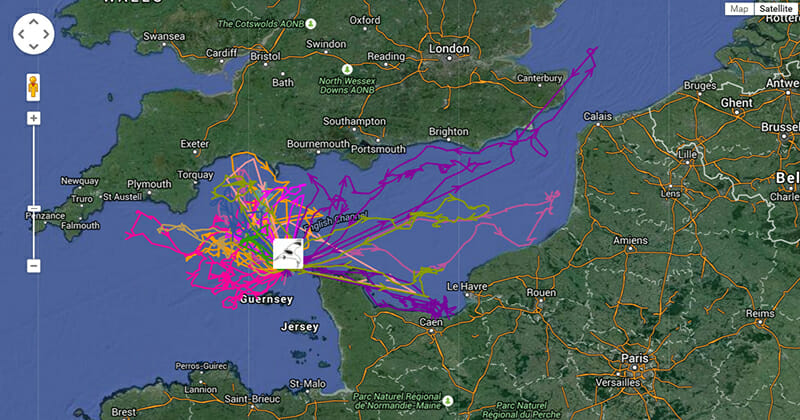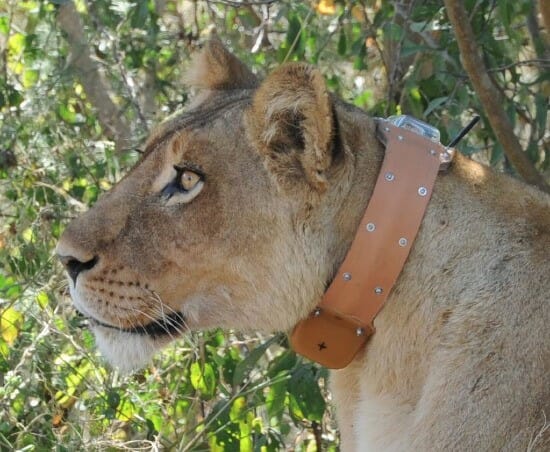GPS Tracking Animals to Understand Their Behaviour Patterns
As mankind grows and expands their civilisation, nature and animals are becoming endangered. In accordance with nature’s guidelines, each and every living creature on this planet is vital and has their own significant ecosystem. Also, people use certain animals to make medicine and treatments to cure illnesses.

There are national parks which are home to many uncommon and endangered species to protect them from hunting and poaching. For example, some tiger species and pandas are endangered animals and it is important to keep these animals safe; that is why GPS Tracking devices are necessary to track their movements and location. If these endangered animals get hurt or injured, we can locate them and treat their injuries in a timely manner.
However, in wildlife, animals can also get sick or there can be some circumstances where they need a vaccine for their conditions. The main problem in these types of scenarios is the fact that in huge animal sanctuaries, it is very hard to keep track of these animals. For this reason, we may need to search the entire park sometimes. To avoid such challenges, park administrators can make use of GPS Tracking systems and locate the targeted animal in a matter of minutes.
How do GPS Trackers work?
GPS tracking devices enable locating the animals remotely with the help of GPS tracking collars to help an animal in need. By using the Global Positioning System (aka GPS), the tracking devices can provide the animal’s exact global satellite position and send location updates at preset intervals. Locations are logged and may then be downloaded in a different way.
The older generation GPS collars were only able to store the location data up until the collar was recovered. However, modern GPS collars allow the location data to be received remotely. GPS/GSM collars use GSM mobile phone signals to obtain and transmit information. GPS collars use Geostationary Satellites to send out the positioning along with other info to the tracking server or PC.
Data Acquired Using GPS
Position of a tracked animal can be saved to determine the environment and the living conditions, however, no behavioural information can be documented unless the tracking device has a VHF connection.
Mortality Sensing Unit: If Mortality sensing unit is equipped with a VHF connection, radio signals can be sent faster if the animal has not moved for longer than 4 hrs. Alternatively, GPS location is a fixed point.
Temperature sensing unit: Temperature sensing unit can be used to detect the body heat of animal.
Comparator Device: Comparator’s function is always to give reduced or higher output if the temperatures are above or below the edge degree correspondingly.
LCD display: LCD display can be used to monitor different information on Digital.
Microcontroller: The microcontroller performs a variety of features like reading through coordinates from GPS Tracking Device.
Wildlife on Google maps: Once the user has received the positioning parameter available as text SMS or any other structure, he then may use this location data on The Search Engines map to look for the exact physical location.
Benefits of GPS Tracking Devices
- They don’t need individual attention as the tracking process is entirely automated.
- The devices are easy to use and track.
- This method is safer for animals and does not harm them in any way.
- This method is extremely practical and quick in comparison with other methods.
GPS Tracking Applications
- GPS wildlife animal tracking devices can be used to identify and find all the animals in nature, jungle and national parks.
- You can use it to search and rescue pet animals for domestic purposes.
- Police forces use GPS trackers in criminal cases most of the time. The police department uses cop dogs to search the traces of thieves and criminals, so trackers are very helpful in such situations.
The best feature of a wild animal tracking device is geofence. Basically, geofence allows you to set a digital fence around a location on the map. Since GPS in wildlife conveys details about each movement, it will send you notifications whenever an animal enters or leaves the geofenced zone. This means you don’t have to closely keep a track of movements as the geofence feature will alert if animals step out of the restricted area.
Conclusion
GPS Tracking devices are sophisticated gadgets that can be used to protect nature. Using these advanced telematics products, tracking an animal, wildlife or a pet continues to be easier than ever.
FAQ’s
What is wildlife tracking?
In simple terms, wildlife tracking tracks the whereabouts and movements of animals. Radio tracking technology can help to determine the precise location of an animal and what the animal is doing. With this data, wildlife teams and scientists can monitor the daily movements of the animal and its habitat and allow reproduction or focus on animal control.
Nevertheless, tracking systems are divided into three categories–satellite tracking, VHF radio tracking, and global positioning system (GPS) tracking.
VHF radio tracking has been in use since 1963. The animal is first sedated, and then a radio transmitter is fitted on the animal. The transmitter sends a signal to a radio receiver and antenna. However, the antenna should be close to the transmitter to pick up signals. Initially, these radio transmitters were big in size, but scientists have been able to keep the size small now.
Satellite tracking is like VHF tracking, but the only difference is that radio signals will be sent to the satellite instead of a radio receiver. Satellite tracking overcomes the drawback of area limitation of VHF tracking–it doesn’t need to be near the antenna to gain radio signals. All they need is a modern computer.
The latest and the best tracking is GPS tracking. Rather than a transmitter, a radio receiver is placed on the animal, and the receiver picks up signals from at least 4 special satellites orbiting the Earth. A computer on the receiver calculates the animal’s location, sends this data to another set of satellites, and these send to scientists. So, GPS tracking wildlife will help you determine the animal’s location anywhere on Earth.
Today, you can use GPS data and high-resolution satellite images to track animal movements, patterns, behaviour, and much more. GPS tracking can help the team to understand why and where animals are getting lost, along with other data.
Why do we need wildlife tracking?
Today, around 41,000 species are at risk of extinction, and 16,300 are endangered. Over the past few decades, human encroachment, like urbanisation and deforestation, have triggered global warming and climate change, affecting thousands of species.
Besides this, wildlife tracking and illegal poaching drive the numbers and affect the entire wildlife geography. What is needed is strong conservation efforts and stricter wildlife preservation laws to save our habitat before we risk losing any more species.
Conservation agencies have to consider different wildlife needs to ensure proper security. Conservationists can use wildlife tracking devices to monitor animal movements and achieve their goals. Besides tracking animal movements, a wildlife GPS tracker can help with species demographics, habitat utilisation, poaching events, and much more.
This data can help them to plan their conservation activities and augment the impact of their purpose. GPS tracking animals will help conservation agencies directly monitor animals and their activities, get notified of any problems, and quickly work on them. Ultimately, we must protect our habitat before more animals become extinct, and technology can significantly help here.
What are the advantages of animal tracking and GPS systems?
GPS systems for animal tracking offer several advantages. It is very beneficial for livestock tracking because even one cow or sheep that goes missing can cost a lot of money.
- Animal tracking and GPS systems can help you know the precise location details of your animals.
- Nowadays, you can track the movement of animals in real time, giving better visibility.
- It gives you the peace of mind that your animals are safe; if they aren’t, you can track and recover them soon.
- You also get other insights like animal behaviour, if any animal is always away from the herd, eating habits, etc.
- Cutting-edge GPS trackers can also give you information about the animal’s health condition, helping you detect anything unusual before it worsens.
Which are the good tracking devices for animals?
Wildlife tracking is helpful in many ways and has been gaining importance recently. Manywildlife GPS trackers are available to help you track your animals, and Rewire Security’s portable GPS trackers assist you with precise and reliable tracking of animals.
The Spytrack Nano weighs only 68 gms and offers 10 days of standby and the Spytrack Plus with 2 months of standby. With GPSLive cloud-based GPS Tracking platform, you can view the location data of all animals from a single interface as the data is backed to the cloud.
GPSLive also offers reports on animal behaviour and movements. It provides wide coverage and ensures a strong signal across 150 countries. Further, you’ll be notified if the animal has gone too far or if anything unusual takes place. All the notifications are sent on your smartphone, which means you can view them anytime, anywhere.




Looking for price of tracker please thanks
Hi Brittany
One of our team will be in touch via email shortly.
hi,
we need the gps tracker which covers 1km for tracking the animals.
from the device,we should know the speed of the animals
Thank you for your question. One of our team will be in touch via email shortly.
Hi,
Need a GPS tracker that gets location every 20 minutes, to attach to goats. Waterproof, built in battery and lightweight if possible.
Best regards,
Jon
Thank you for your question. One of our team will be in touch via email shortly.
Hi there
I need similar type of device but with minimal features.
1. Two times GPS location of animal in 24 hours to save battery
2. Small in size
3. Long inbuilt battery life
4. Waterproof
5. SIM card enabled for fetching GPS location
Hi Deepak, One of our team will be in touch via email shortly.
Hello !
We need like this device but with additional features like :
Ability of tracking any time, anywhere, with a battery with the longest possible life and Waterproof .
We need a lot of them depends on the cost.
We are interested in the costs for a GPS tracking system for European Red Squirrels – https://en.wikipedia.org/wiki/Red_squirrel (340 grams)
Please could you send us typical start up and ongoing costs, we believe we would require the implanted transmitters in order to avoid animal stress (collars can not be left attached for more than 12 months). minimal handling needs to be observed
The number required will be relative to cost per unit, all squirrels are located in North Wales UK
Advice and further information would be most welcome
Thanks
Peter
Hi Peter,
One of our team will contact you via email.